This article is more than 1 year old
Intel and server buddies forge micro boxes
Tiny Xeon blade-rack hybrids
Two options
There are two different variants of the micro server module. One that is designed for a machine with front access in the chassis, where the servers will slide in, and another where the server modules will be pushed into the chassis from the top, like a PCI-Express card is today in most servers. Here's the conceptual front access micro server from the SSI spec:
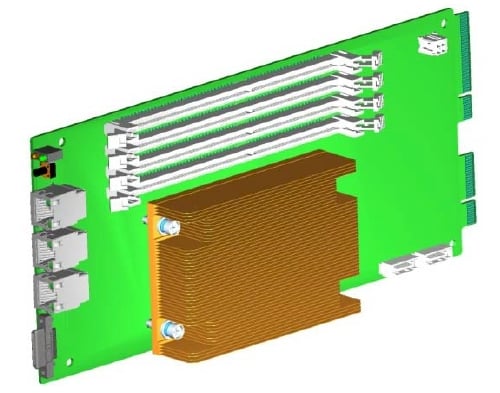
And here is the top access version:
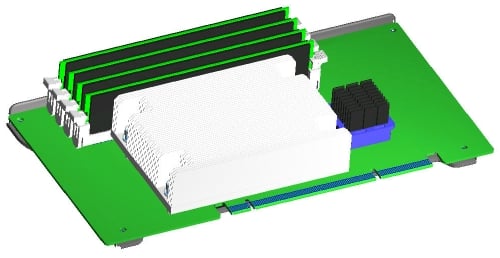
Notice how the spec doesn't say anything about what processors, chipsets, memory, or network interconnect is to be used? That's because the SSI's micro server spec is processor neutral, and there is every reason to believe that Dell, Tyan, Quanta, and others will adapt the basic design to support multiple processors. Dell like both Opterons and Xeons, particularly in the Data Center Solutions bespoke server lineup; Tyan has always been happy to support both Xeons and Opterons in its boards and systems.
Quanta also is playing around with Tilera's many-cored chips (these are probably derived from the MIPS designs, but thus far Tilera has never confirmed that). That said, Intel is very interested in small servers, just in case this market takes off like tablets did - despite the naysayers who said there was no market in it.
Here's the prototype micro server that Waxman was passing around last week
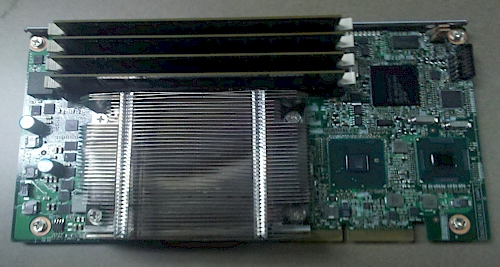
Waxman did not identify what the processor was underneath the heat sink, but he did say it was a four-core chip and that it was designed with an unnamed ODM partner as a reference product, not as something Intel will sell directly. This board had four DDR3 memory sticks, using Samsung Electronics' low-volt "green" memory modules, and it looked like the interconnect running along the bottom of the module was a modified PCI-Express 2.0 x16 slot. This is the same interconnect technique that SeaMicro uses in its SM10000 series of Atom-based micro servers, which cram 512 cores into a 10U chassis. The difference is that the SeaMicro board has two PCI-Express 2.0 x16 connections, and this Intel prototype only has one. This Intel machine is obviously for a top access micro server chassis.
Here's a micro server module from Tyan, which El Reg has spotted in the wild and which is for a front access micro server chassis:
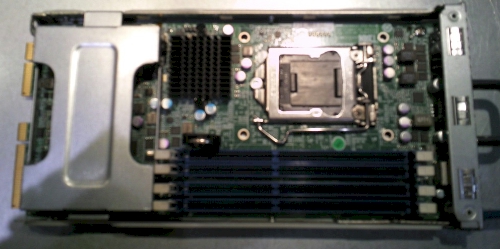
And here is what that Tyan prototype micro server 4U chassis looks like:
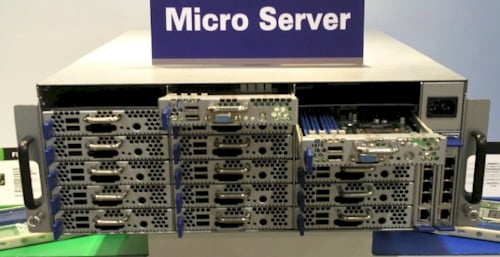
The Tyan chassis will support up to 18 single-processor micro servers in that 4U chassis, along with shared Gigabit or 10 Gigabit Ethernet switches and power supplies for all those nodes. The "micro blades," as Tyan is calling them, will support the future single-socket "Sandy Bridge" Xeon E3 processors or AMD's Phenom II, Athlon II, and Sempron processors in the AM3 socket. The Tyan micro servers will sport 32 GB of ECC memory, space for two 2.5-inch SATA disks, and two network ports. The chassis has a management module that sits in with the switches and consolidates all of the BMC operations.
As it turns out, the Dell DCS "Viking" server announced last September is a modified version of a front-access micro server that adheres to the SSI spec, but which adds a fat server tray to the end of the drawer so customers can use inexpensive 3.5-inch disks.
The most interesting product coming out of Intel for micro servers will no doubt be the single-socket variant of the Sandy Bridge Xeon processors, which are the kickers to the current Nehalem-derived Xeon 3400 series. The power-sipping E3 chip will have two cores running at around 2.2 GHz and only burn 20 watts. But there could be other Atom-based designs, something like what SeaMicro has put together with the SM10000 but probably not as dense. Future micro servers based on ARM RISC processors and "Bulldozer" Opterons will also probably appear at some point, too. ®
